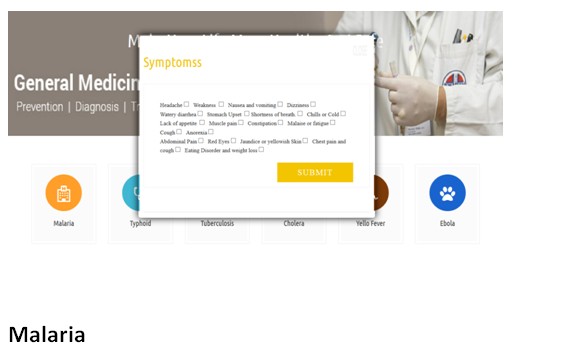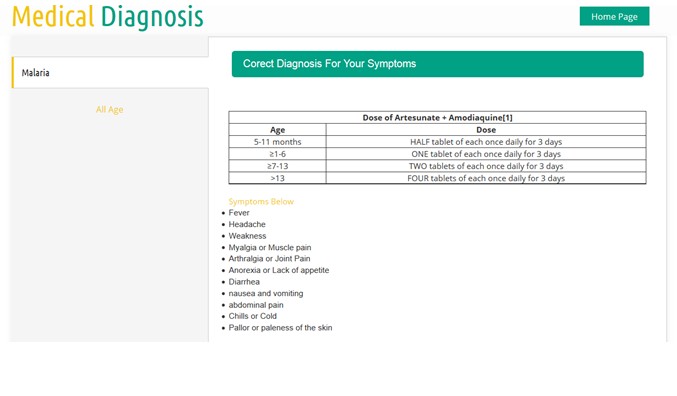Advertisements
Design and Implementation of an Online Medical Diagnosis and Consultancy System
Content Structure of Design and Implementation of an Online Medical Diagnosis and Consultancy System
The abstract contains the research problem, the objectives, methodology, results, and recommendations
- Chapter one of this thesis or project materials contains the background to the study, the research problem, the research questions, research objectives, research hypotheses, significance of the study, the scope of the study, organization of the study, and the operational definition of terms.
- Chapter two contains relevant literature on the issue under investigation. The chapter is divided into five parts which are the conceptual review, theoretical review, empirical review, conceptual framework, and gaps in research
- Chapter three contains the research design, study area, population, sample size and sampling technique, validity, reliability, source of data, operationalization of variables, research models, and data analysis method
- Chapter four contains the data analysis and the discussion of the findings
- Chapter five contains the summary of findings, conclusions, recommendations, contributions to knowledge, and recommendations for further studies.
- References: The references are in APA
- Questionnaire.
Chapter One Of Design and Implementation of an Online Medical Diagnosis and Consultancy System
INTRODUCTION
GENERAL INTRODUCTION
Medical establishments like hospitals, rehabilitation centers, health-saloons etc. are seen as figures of hope when struck with illness. Just like other organizations, medical establishments are also well-organized, following rigid and complex processes. In recent years, records have shown an increase in inaccuracy and imprecision in medical diagnosis as most patient who are unable to a clinic for proper diagnosis end up treating sickness inappropriately. The advent of computer and internet has made it possible for millions to access proper medical diagnosis and are administer correct treatment procedures. Today, several algorithm, models and technologies are put in place to ensure accurate and precise diagnosis on patient which in turns has reduce the rate of mortality in the country and world at large. One of such technologies is fuzzy logics
Online Medical Diagnosis Software(OMDS) automates the whole process of patience diagnosis with accurate and precise result using a well detail and proven algorithm to achieve it desire output, one of such algorithm is fuzzy logic a branch of artificial intelligent. Using the software will remove all such complexities as it helps you retrieve your information accurately.
Advertisements
INTRODUCTION
Chapter one introduces the research work and the problem definition of the research, and to know the aim of this research work, research justification tells us why it is important to research on this topic; it also covers areas like scope and limitation of study which entails the boundary of this work. Definition of terms gives summarize what each chapter entails.
PROBLEM DEFINITION
This research work OMDS was undertaken to uncover some of the problems that characterized the traditional method of medical diagnostic which has taken many lives. Here patient take drugs base on ancient myth, past experience and drugs availability not knowing that same symptom can cut across several illnesses and thereby engaging in drugs abuse.The propose OMDS is meant to diagnose various diseases in an expert system such as Malaria, Typhoid, Cholera, Ebola etc. Fuzzy logic is chosen as the artificial intelligence tool employed in the proposed system because it is one of the most efficient qualitative computation methods
OBJECTIVE OF STUDY
In view of the problems mentioned above, this project is aimed at implementingOnline Medical Diagnosis Software (OMDS) which will exclusively:
- Diagnose and display accurate result from the selected symptom selected by the patient or users
SCREEN SHOTS OF THE APPLICATION
RESEARCH JUSTIFICATION
This research work will provide a reliable way of handling patient diagnosis as the result are gotten from well know medical institution. This research work which will be deployed online will be readily available to everyone not able to access a professional consultant or health practitioners.Furthermore, it will aids structural document representation of drugs and symptoms for all disease cover in this system. This research will also contribute to existing literature in this area and will serve as a guild or blueprint for an undergraduate student.
RESEARCH METHODOLOGY
This research work “design and implementation of an interactive project management system” will be a web-based application and will be implemented on a relational database system(MySQL). Html(hypertext markup language), css(cascading style sheet) and Jquery will be used to design the web-user interface, php (hypertext preprocessor) will be used as the serve- side script language to link the interface and the database.
SCOPE AND LIMITATION OF STUDY
This research work is to develop a system capable of diagnosing only disease and their symptoms stated below.
Malaria:
Symptoms of malaria
- Fever
- Headache
- Weakness
- Myalgia or Muscle pain
- Arthralgia or Joint Pain
- Anorexia or Lack of appetite
- Diarrhea
- nausea and vomiting
- abdominal pain
- Chills or Cold
Cholera
Symptoms:
- watery diarrhea
- volume depletion or dehydration
- vomiting
- abdominal pain or stomach pain
- lethargy or Laziness or Fatigue
Typhoid
Symptoms:
- high fever
- dull frontal headache
- abdominal pain
- anorexia: eating disorder and weight loss
- constipation
- cough
- diarrhea
- malaise or fatigue
- chills
Yellow Fever symptoms:
- fever
- conjunctiva injection or Red eyes
- relative bradycardia or Slow heart beat
- Jaundice or yellowish Skin
- hemorrhagic diathesis or Bleeding
- hypotension or Low blood Pressure
- hypotension
- lethargy or Laziness or Fatigue
- vomiting
Ebola
Symptoms of Ebola include:
- Fever
- Severe headache
- Muscle pain
- Weakness
- Fatigue
- Diarrhea
- Vomiting
- Abdominal (stomach) pain
- Unexplained hemorrhage (bleeding or bruising)
Tuberculosis
Signs and symptoms of active TB include:
- Coughing that lasts three or more weeks.
- Coughing up blood.
- Chest pain, or pain with breathing or coughing.
- Unintentional weight loss.
- Fatigue.
- Fever.
- Night sweats.
- Chills.
The system will not incorporate in its development all the functions of a diagnosis system but will focus only on the aforementioned functionalities. The system will not be responsible for any loss of data if its environment (network/system installed on) is corrupt.
CHAPTER LAYOUT
This section was put in place to explain what each chapter does, chapter one introduces the project to the reader by explaining the problems the project is supposed to solve, objective of the study and research justification is to describe to the reader the purpose and the importance of researching on this topic, research methodology is all about the method used in implementing the research work, scope and limitation describes the boundary of the research work and where the project work can be put into use.
Chapter two deals with the literature review and state-of-the-art.This chapter discusses literature review, what people have published related to this research work and their shortcoming, how this present research can improve their shortcomings.
Chapter three deals with the system design methodology i.e. collection of tools methods and practices for achieving a task; the requirement specification states the expectation of the system analysis, and design which is the blueprint of what the system would carry out.
Chapter four has to do with the implementation, system testing strategies, target computer system requirement, software maintenance etc.
Chapter five discusses the recommendations and conclusion part of the research work and how this work can be applied to the problem domain.
Definition of term
OMDS: Online medical diagnosis system.
Advertisements





